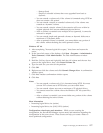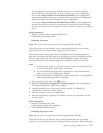More information
v Understanding stripe-unit size
v Understanding creating basic arrays
v Creating logical drives (action)
v Increasing logical drive size (action)
v Increasing logical drive size (SAS, SATA) (action)
Understanding
scheduled tasks: The ServeRAID Manager Task Scheduler allows
you to run lengthy operations at a convenient time, such as a logical drive
migration or synchronizing a logical drive. All schedulable tasks work the same
way: To schedule a migration, for example, you perform the standard set of steps;
then, in the last step, you can choose to run the task immediately or to schedule it
for another time.
You can run the task at the given date and time or make it a recurring task. If the
task is recurring, it runs on a regular basis according to the interval you choose:
the same time each day, the same time each week, or the same time each month.
Not all tasks can be recurring tasks. For example, a logical drive migration cannot
be a recurring task.
The Task Manager is a tool that you can use to manage scheduled tasks. It allows
you to:
v Modify a task’s schedule
v Delete a scheduled task
v View task properties
Start time validation
When you schedule a task, it executes on the agent machine which may be a
remote machine in a different time zone. To prevent scheduling problems due to
time differences between the agent and client machines, the Task Scheduler
performs the following checks:
v To accommodate differences in times zones, you can schedule a task up to 23
hours in the past, pending approval by the agent.
v If the agent determines that the task is scheduled in the past (based on the local
time on the agent machine), it will reject the task and you will be prompted to
select a different date and time.
Missed
start times
If a non-recurring task misses its start time, the Task Manager flags it with an
error. You must modify the task schedule if you want to run it at another time.
If a recurring task misses its start time, it is rescheduled to run at the next
scheduled interval. Example: a recurring task runs every Monday at 1:00 AM. The
agent machine is powered off at that time. When you restart the agent machine,
the missed task is rescheduled to run the following Monday at 1:00 AM.
Note: To accommodate temporary or brief interruptions on the agent machine,
each task has a 30-minute grace period built into its start time. Example: a
task is scheduled to run at 10:00 PM. A power outage lasts 20 minutes, from
9:55 PM to 10:15 PM. The task runs at 10:15 PM.
Chapter 4. Managing ServeRAID devices 175


















